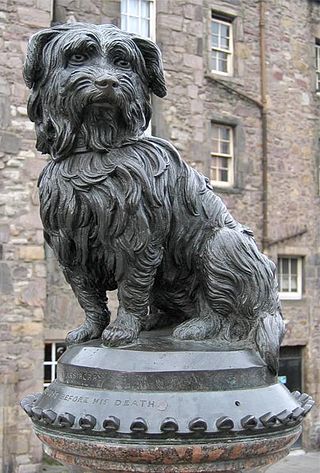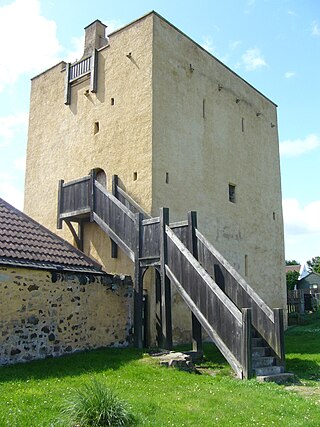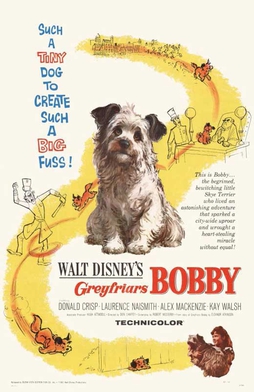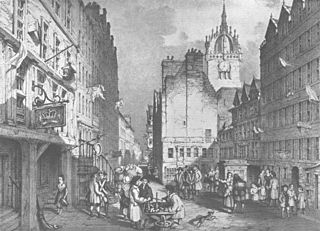


William Little (or Littil) of Liberton (1525–1601) was a 16th-century Scottish merchant and landowner who served as Lord Provost of Edinburgh 1586/87 and 1591/92. [1] He was one of the founders of Edinburgh University.



William Little (or Littil) of Liberton (1525–1601) was a 16th-century Scottish merchant and landowner who served as Lord Provost of Edinburgh 1586/87 and 1591/92. [1] He was one of the founders of Edinburgh University.
He was born in 1525 the son of an Edinburgh merchant and city burgess. He was descended from Edward Little who came to Edinburgh around 1500 as a cloth merchant. [2]
At the Reformation of 1560 the family converted to Protestantism. [3]
In 1582 Little was one of the founders of Edinburgh University on the site of Kirk o'Field Church. [4] His benefaction included donation of 300 legal books previously owned by his older brother Clement Little, an advocate who died in 1580. These books created the foundation of the Edinburgh University Library. [5] The site of the original university remains in university use but was redeveloped in the late 18th century as Old College.
He was a city burgess in the 1580s and in 1586 succeeded James Stewart, Earl of Arran as Provost. He was replaced in turn from 1587 to 1591 by John Arnot of Birswick, before serving a second term as Provost 1591 to 1592, thereafter being succeeded by Nicol Uddert. [6]
In 1587 he purchased Liberton Tower from the Forrester family of Corstorphine, but found it unsuited to his needs and instead built Liberton House nearby around 1600. Liberton House contains a lintel inscribed "William Litil 1570" brought from an earlier house (probably in the Scottish Borders). [7]
On 26 October 1591 Little was appointed to a commission to try, examine, and if required torture people suspected of witchcraft. The others appointees were Sir John Cockburn of Ormiston, David MacGill of Nesbit, Robert Bruce, John Duncanson, and John Arnot. [8]
He died on 24 November 1601. He was buried in the then relatively new Greyfriars Kirkyard in Edinburgh. Greyfriars Kirk was at that time still unbuilt and the ground was for burial only. Little and others such as George Buchanan were some of the graves removed in a purge of monuments in the early 17th century, and stones were thereafter banned in the main grass areas. The new rules only allowed monuments on the outer wall, and this is where Little's descendant, also William Little applied in 1680 to erect a monument, being obliged to create a monument on an outer wall, under the rules. Being also charged 3000 Scots pounds for this privilege, the monument is necessarily grand. The grave is a memorial only as, whilst Little is definitely in the graveyard, this is not the position. [9]
He is now mainly remembered for this elaborate stone tomb in Greyfriars Kirkyard, which was completed in 1683 and is one of the most distinctive in the graveyard. The tomb shows Little lying recumbent, propped by his elbow, under a canopy supported on six Corinthian columns and topped by two female figures (representing Lady Justice and Prudence). Documents mention four figures on the tomb, representing moral virtues. [10]
The railings and pillars on the church side are not part of the original design and were added in 1770 to provide enclusue, being designed by Thomas Sibbald. [11]

Greyfriars Bobby was a Skye Terrier or Dandie Dinmont Terrier who became known in 19th-century Edinburgh for spending 14 years guarding the grave of his owner until he died on 14 January 1872. The story continues to be well known in Scotland, through several books and films. A prominent commemorative statue and nearby graves are a tourist attraction.

John Dalrymple (1734–1779) was a Scottish writer who twice served as Lord Provost of Edinburgh.

Liberton is a suburb of Edinburgh the capital of Scotland. It is in the south of the city, south of The Inch, east of the Braid Hills and west of Moredun.

Liberton Tower is a four-storey, square-plan tower house in the Edinburgh suburb of Liberton, on the east side of the Braid Hills.

Greyfriars Bobby is a 1961 American drama film starring Donald Crisp and Laurence Naismith in a story about two Scottish men who compete for the affection of a Skye Terrier named Bobby. The screenplay by Robert Westerby was based upon the 1912 novel Greyfriars Bobby by Eleanor Atkinson which was based, in turn, upon an incident in 19th century Edinburgh involving a dog that came to be known as Greyfriars Bobby. It was the second film based upon Atkinson's novel, the first being Challenge to Lassie in which Crisp also starred. The film was directed by Don Chaffey and shot at Shepperton Studios and on location in Scotland. The film has been released to DVD and Disney+.

The Canongate Kirkyard stands around Canongate Kirk on the Royal Mile in Edinburgh, Scotland. The churchyard was used for burials from the late 1680s until the mid-20th century.

Greyfriars Kirkyard is the graveyard surrounding Greyfriars Kirk in Edinburgh, Scotland. It is located at the southern edge of the Old Town, adjacent to George Heriot's School. Burials have been taking place since the late 16th century, and a number of notable Edinburgh residents are interred at Greyfriars. The Kirkyard is operated by the City of Edinburgh Council in liaison with a charitable trust, which is linked to but separate from the church. The Kirkyard and its monuments are protected as a category A listed building.
Sir James Stuart of Binend (1716–1777) was an 18th-century Scottish merchant who was twice Lord Provost of Edinburgh 1764 to 1766 and 1768 to 1770.
Sir Robert Chieslie of Dalry was a Scottish merchant who served as Lord Provost of Edinburgh from 1694 to 1696.
Sir William Nisbet of Dean was a 16th/17th century Scottish merchant who twice served as Provost of Edinburgh from 1616 to 1619 and 1622 to 1623.
Sir Archibald Tod (1584–1656) was a 17th-century Scottish landowner and merchant who twice served as Provost of Edinburgh, from 1646 to 1648 and 1651 to 1654. Tod represented a moderate force during a period of political extremes.

Sir John Byres of Coates (1569–1629) was a 16th/17th century Scottish banker and merchant who served as Treasurer and Old Provost for Edinburgh Town Council. Old Provost is the equivalent of Deputy Provost.

Alexander Forrester (1611–1686) was a Scottish minister of the 17th century.
John Arnot of Birswick (Orkney) (1530–1616) was a 16th-century Scottish merchant and landowner who served as Lord Provost of Edinburgh from 1587 to 1591 and from 1608 to death. He was Deputy Treasurer to King James VI.

Henry Nisbet (1535–1608) was a 16th-century Scottish merchant and Provost of Edinburgh for 1597/98.
Alexander Clark of Balbirnie was a Scottish merchant and Provost of Edinburgh. He was closely involved with English diplomacy.

Alexander Miller or Millar (1559-1616) was an Edinburgh tailor who served James VI and I.
James Alston (1679–1733) was a Church of Scotland minister who served twice as Moderator of the General Assembly in both 1725 and 1729. He was Chaplain in Ordinary to the King.